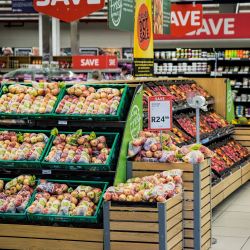My Medpage feed offered up this headline: "Let's Stop Subsidizing Obesity." I thought I would find an argument over the continued financial support for sugar and corn. Then, I caught the subhead, “Government benefits should only be spent on nutritious foods.” Let’s consider their argument.
You can find the article here. The authors of this opinion piece suggest that the nutritional needs of individuals receiving assistance from SNAP, the Supplemental Nutritional Assistance Program (formerly Food Stamps), would be improved by instituting “reforms that promote healthier eating.” While the program was initially designed to reduce food insecurity and now provides assistance in purchasing foods for roughly 40 million Americans; the growing obesity epidemic means that perhaps a bit of “mission creep” is in order – to steer the “bad food” choices of these individuals towards the more nutritious.
According to the authors, SNAP
“…is contributing to the obesity epidemic. Beyond a prohibition on the purchase of hot food, alcohol, tobacco products, vitamins, or medicines, virtually any other food or beverage item -- including soda, candies, and processed meats -- can be purchased with SNAP benefits.
The result is high levels of SNAP spending on many of the foods and beverages at the root of the nation's obesity epidemic. About 20 cents of every SNAP dollar goes toward sweetened beverages, desserts, salty snacks, candy, and sugar, according to a report commissioned by the U.S. Department of Agriculture (USDA). Soft drinks, potato chips, and processed meats are among the top ten items purchased with SNAP benefits.”
That idea, that SNAP participants made "bad choices" got my attention. The authors provided a link to their information source. Here is what the report actually states.
“There were no major differences in the expenditure patterns of SNAP and non-SNAP households, no matter how the data were categorized. Similar to most American households:
- About 40 cents of every dollar of food expenditures by SNAP households was spent on basic items such as meat, fruits, vegetables, milk, eggs, and bread.
- Another 20 cents out of every dollar was spent on sweetened beverages, desserts, salty snacks, candy and sugar.
- The remaining 40 cents were spent on a variety of items such as cereal, prepared foods, dairy products, rice, and beans.”
So, while it is true that 20 cents out of every dollar of SNAP money are spent on “nutritionally bad” food and that soft drinks, potato chips, and processed meats are in the top 10 for SNAP participants, it is no different than the purchases made by non-SNAP households with similar demographics. Overall, the differences in purchases amounted to a shifting of 3 cents.
SNAP is not encouraging or supporting poor choices.
But the authors had more to say about SNAP.
“SNAP participation is also associated with increased body weight, and the program's beneficiaries have lower dietary quality and worse health indicators than those who are eligible for the program but don't participate.”
While the cited study does indicate lower dietary quality, the differences, based on a scoring system, amount to a quarter cup or so of additional fruit and vegetables. As to the increased body weight that was at the baseline, SNAP participants were more frequently obese, to begin with than those non-SNAP participants. The two groups differed significantly in other consequential ways.
“47.2% of SNAP participants had <12 y of education compared with 28.6% of nonparticipants 84.2% of SNAP participants lived below the poverty line compared with 71.0% of nonparticipants
…SNAP participants also differed significantly from nonparticipants with respect to age, sex, race-ethnicity, place of birth, marital status, and health insurance coverage.”
Does it seem fair to compare two such dissimilar groups?
If the SNAP participants cannot be counted on to make good choices, the authors suggest that restrictions on purchases might be helpful. While at its heart, this denies SNAP participants autonomy, they note that other programs impose food eligibility restrictions.
“Restrictions on benefits-eligible foods would not be unique to SNAP. Other federal programs, such as the Special Supplemental Nutrition Program for Women, Infants, and Children (WIC), prohibit beneficiaries from purchasing candy, soda, or snack foods. …Such restrictions are likely one reason why participation in WIC is not correlated with increased body mass index.”
Of course, as I hope is becoming evident in this opinion piece, the authors' citation, the "proof" of their view, tells a different story.
“No studies in women and only seven studies in children have examined whether participation in the WIC program is associated with risk for obesity. The studies in children have produced mixed results.”
"Not correlated with increasing body mass index" is not the same as "no studies" or "mixed results."
There are other ways to improve dietary choices in addition to restricting choice. The authors point to a study that subsidized purchasing fruits and vegetables by offering a 30% discount on their cost returned to the participant’s SNAP benefits. These incentives resulted in:
“Consumption of fruits and vegetables was 26% higher among those in the pilot project relative to those who were not.”
That 26% represented the quarter of a cup of fruits and vegetables per day I mentioned earlier, a value the authors described as “both statistically significant and large enough to be nutritionally relevant.” It amounted to a savings of $3.65/month, And though I looked high and low, there was no information on how that additional money was spent. Did it go for “sweetened beverages, desserts, salty snacks, candy, and sugar,” as they alluded to at the beginning of their opinion piece? If so, then overall nutritionally, the effect might be neutral or even harmful; no one knows.
Is this the regulatory science we use in policy decisions? Who checks to see whether the statements match the underlying evidence? Part of scientific transparency is making sure our words convey the results, not the story we wish to tell.

